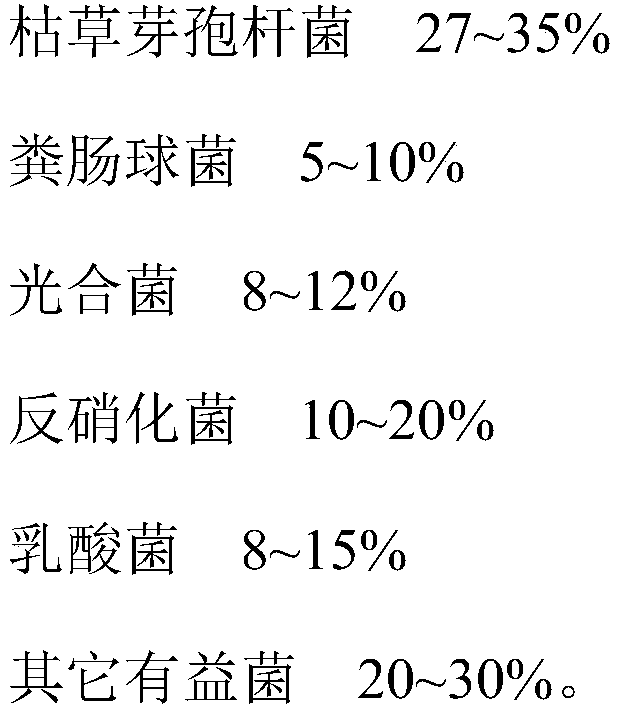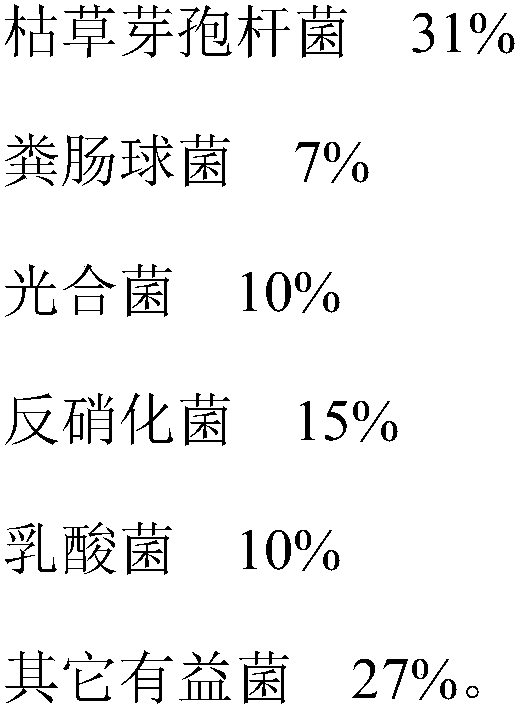Microbial deodorant
A deodorant and microbial technology, applied in the direction of biological water/sewage treatment, special treatment targets, water/sludge/sewage treatment, etc., can solve the problems of shortening deodorization time and long deodorization time, so as to reduce COD and Ammonia nitrogen content, stable deodorizing effect
- Summary
- Abstract
- Description
- Claims
- Application Information
AI Technical Summary
Problems solved by technology
Method used
Image
Examples
Embodiment 1
[0033] The microbial deodorant of the present embodiment comprises water and beneficial bacteria, wherein, the quantity of beneficial bacteria contained in every ml of water is 1.5 billion, and the total mass fraction is 100%, and the mass fractions of beneficial bacteria are as follows,
[0034] Bacillus subtilis 27%
[0035] Enterococcus faecalis 10%
[0036] Photosynthetic bacteria 12%
[0037] Denitrifier 18%
[0038] Lactic acid bacteria 13%
[0039] Filamentous fungi 5%
[0040] Yeast 5%
[0041] Other beneficial bacteria 10%.
Embodiment 2
[0043] The microbial deodorant of the present embodiment comprises water and beneficial bacteria, wherein, the quantity of beneficial bacteria contained in every ml of water is 1.8 billion, and the total mass fraction is 100%, and the mass fractions of beneficial bacteria are as follows,
[0044] Bacillus subtilis 31%
[0045] Enterococcus faecalis 7%
[0046] Photosynthetic bacteria 10%
[0047] Denitrifier 15%
[0048] Lactic acid bacteria 10%
[0049] Filamentous fungi 8%
[0050] Yeast 8%
[0051] Other beneficial bacteria 11%.
Embodiment 3
[0053] The microbial deodorant of the present embodiment comprises water and beneficial bacteria, wherein, the quantity of beneficial bacteria contained in every ml of water is 2 billion, and the total mass fraction is 100%, and the mass fractions of beneficial bacteria are as follows,
[0054] Bacillus subtilis 35%
[0055] Enterococcus faecalis 5%
[0056] Photosynthetic bacteria 10%
[0057] Denitrifier 10%
[0058] Lactic acid bacteria 10%
[0059] Filamentous fungi 10%
[0060] Yeast 10%
[0061] Other beneficial bacteria 10%.
[0062] The microbial deodorant of the present invention has a removal rate of up to 95% for ammonia nitrogen, H 2 The removal rate of S can reach up to 90%, the degradation rate of odor concentration can reach 90%, the inhibition rate of bacteria in farms can reach 92%, and the degradation rate of garbage odor concentration can reach 90%, which can significantly reduce COD and ammonia nitrogen in sewage content, effectively degrades the odo...
PUM
 Login to View More
Login to View More Abstract
Description
Claims
Application Information
 Login to View More
Login to View More - R&D
- Intellectual Property
- Life Sciences
- Materials
- Tech Scout
- Unparalleled Data Quality
- Higher Quality Content
- 60% Fewer Hallucinations
Browse by: Latest US Patents, China's latest patents, Technical Efficacy Thesaurus, Application Domain, Technology Topic, Popular Technical Reports.
© 2025 PatSnap. All rights reserved.Legal|Privacy policy|Modern Slavery Act Transparency Statement|Sitemap|About US| Contact US: help@patsnap.com


